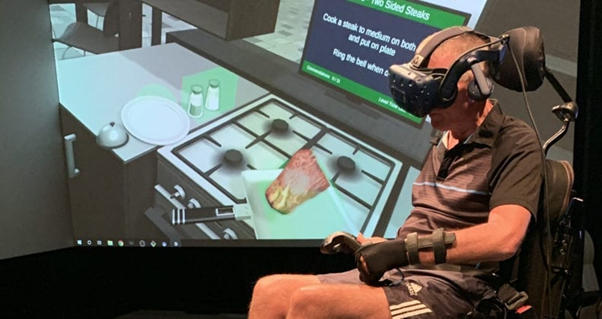Virtual reality ‘steak cooking’ used to treat spinal injuries

An immersive virtual reality (VR) research project at Curtin University that helps individuals with cervical spinal cord injuries improve upper limb function has been given funding from the Insurance Commission to begin a pilot program.
The initial feasibility study with one participant will now be expanded to a minimum of five other participants as part of a six-week pilot program assessing VR technology.
The research team will now collaborate with the participants of the pilot study to create a customised VR experience to address each of their individual rehabilitation needs which will include a range of activities like cooking a virtual steak.
“Virtual tasks include seasoning, frying, flipping and transferring a steak from pan to plate, which when done repetitively over time help improve the participants control and range of upper limb movements,” said Lead Researcher Marina Ciccarelli from Curtin’s School of Occupational Therapy, Social Work, and Speech Pathology
“As part of our current study, we are seeking the advice and opinions of occupational therapists and physiotherapists at one of the major in-patient spinal cord rehabilitation services to see how the home-based VR rehabilitation can be best used as an adjunct to other conventional therapies.”
According to Ciccarelli, the use of VR could maximise opportunities for functional recovery, increase opportunity for daily rehabilitation and minimise time, travel, and therapy costs for the more than 15,000 Australians living with spinal injuries.
“If a spinal cord injury is incomplete, there is a potential to regain sensation, movement, and control through rehabilitation,” said Ciccarelli.
Each session can be completed at home in approximately 30 minutes and requires minimal carer support, with participants having their daily progress in the VR game remotely observed and measured. The therapist can then remotely adjust the difficulty of the simulated activities to present more of a challenge to participants doing well.
“We are using several outcome measures to capture an individual’s progress when using the VR rehab in our pilot project. These include their performance in using the VR game”, said Ciccarelli.
“We can download a summary log that records: the date/time of the session in the game; duration of tasks performed at each level of difficulty; and the number of task completions (e.g. successfully cooked steaks) for each level.”
The pilot team will also obtain measurements of the participants range of motion of their arms and their muscle strength.
Participants will also be interviewed to find out how satisfied they were with using the VR rehab game at home, and if they perceive any improvements to their physical abilities such as movements, strength and endurance when completing everyday activities.
Ciccarelli also believes that VR technology could be used to treat other disabilities that create mobility issues for individuals after having a stroke, limb amputations and numerous other neurological conditions.
“There are many conditions that could benefit from embedding customisable immersive VR serious games into rehabilitation programs, including people who have had nerve transfers after traumatic injuries,” said Ciccarelli.
Commission Secretary, Kane Blackman, said that the pilot study was funded in an effort to increase the independence of individuals living with cervical spinal injuries.
“The cost of lifetime care and treatment for a person with a catastrophic injury, funded by the Insurance Commission, is estimated to be $4m on average,” said Blackman.
“Early and effective can significantly enhance a person’s independence post-injury. This innovative technology allows rehabilitation to occur daily in the home, minimising time, travel and therapy costs associated with attending outpatient rehabilitation”.
In the future, Ciccarelli and her team hope to see VR introduced earlier into the rehabilitation process.
“Ideally this would be while people are still inpatients in hospital, so they are discharged with a VR game that is relevant to their rehabilitation goals as part of a home program,” said Ciccarelli.
“We would love to work with game developers to improve the customisation possible in a wide range of VR games and experiences to allow them to be used as part of rehabilitation for people with different movement abilities and rehabilitation goals.”
SpinalCure Australia, the Minderoo Foundation and Applecross Rotary have also supported the pilot program by collectively funding the purchase of the VR headsets.










